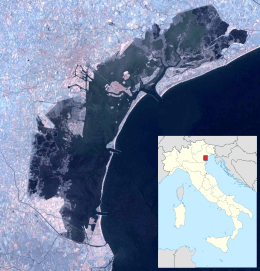Burano
 Burano, view from Mazzorbo | |
 Burano | |
| Geography | |
|---|---|
| Coordinates | 45°29′09″N 12°25′03″E / 45.485771°N 12.417487°ECoordinates: 45°29′09″N 12°25′03″E / 45.485771°N 12.417487°E |
| Adjacent bodies of water | Venetian Lagoon |
| Area | 210,800 m2 (2,269,000 sq ft) |
| Highest elevation | 1 m (3 ft) |
| Administration | |
| Comune | Venice |
Burano is an island in the Venetian Lagoon, northern Italy; like Venice itself, it could more correctly be called an archipelago of four islands linked by bridges. It is situated near Torcello at the northern end of the Lagoon, and is known for its lace work and brightly coloured homes.
Geography
Burano is situated 7 kilometres (4 miles) from Venice, a 40-minute trip by Venetian motorboats, "vaporetti".
The island is linked to Mazzorbo by a bridge.[1] The current population of Burano is about 2,800. Originally, there were five islands and a fourth canal that was filled to become via e piazza Baldassare Galuppi, joining the former islands of San Martino Destra and San Martino Sinistra.
Burano has historically been subdivided into five sestieri, much like the historical center of Venice. They correspond to the five original islands. The sixth sestiere is neighboring Mazzorbo:
| Sestiere | area hectares[2] | popul- ation | density | map | |
| San Mauro | 6,8 | 818 | 12029 |  | |
| Giudecca[3] | 2,5 | 255 | 10200 | ||
| San Martino Sinistra | 4,4 | 586 | 13318 | ||
| San Martino Destra | 5,1 | 759 | 14882 | ||
| Terranova | 2,3 | 359 | 15609 | ||
| Burano (Island) | 21,1 | 2777 | 13176 | ||
| Mazzorbo[4] | 51,8 | 329 | 635 |
Burano has a high population density, calculated at more than 13,000 per square kilometer, or more than twenty times the density of neighboring Mazzorbo. It is almost entirely covered by residential buildings, with few small green areas.
History

The island was probably settled by the Romans, and in the 6th century was occupied by people from Altino, who named it for one of the gates of their former city. Two stories are attributed to how the city obtained its name. One is that it was initially founded by the Buriana family, and another is that the first settlers of Burano came from the small island of Buranello, about 8 kilometres (5 miles) to the south.
Although the island soon became a thriving settlement, it was administered from Torcello and had none of the privileges of that island or of Murano. It rose in importance only in the 16th century, when women on the island began making lace with needles, being introduced to such a trade via Venetian-ruled Cyprus. When Leonardo da Vinci visited in 1481, he visited the small town of Lefkara and purchased a cloth for the main altar of the Duomo di Milano. The lace was soon exported across Europe, but trade began to decline in the 18th century and the industry did not revive until 1872, when a school of lacemaking was opened. Lacemaking on the island boomed again, but few now make lace in the traditional manner as it is extremely time-consuming and therefore expensive.
Main sights
Burano is also known for its small, brightly painted houses,[5] which are popular with artists. The colours of the houses follow a specific system originating from the golden age of its development; if someone wishes to paint their home, one must send a request to the government, who will respond by making notice of the certain colours permitted for that lot.[6]
Other attractions include the Church of San Martino, with a leaning campanile and a painting by Giambattista Tiepolo (Crufixion, 1727), the Oratorio di Santa Barbara and the Museum and School of Lacemaking.[7]
Gallery
- Burano seen from Torcello
 Canal in Burano
Canal in Burano- Terranova sestiere
 Colored houses
Colored houses View from Burano
View from Burano
Notes
- ↑ http://www.vanityfair.com/culture/2012/08/travel-mazzorbo-italy-venice
- ↑ relative area portions measured from map
- ↑ Not to be confused with Giudecca in the sestiere Dorsoduro of the historic center of Venice.
- ↑ Neighboring island (not on map)
- ↑ painted houses
- ↑ http://www.huffingtonpost.com/2013/11/05/burano-italy_n_4212666.html
- ↑ http://museomerletto.visitmuve.it/en/home/
External links
![]() Media related to Burano at Wikimedia Commons
Media related to Burano at Wikimedia Commons
Murano & Burano Islands